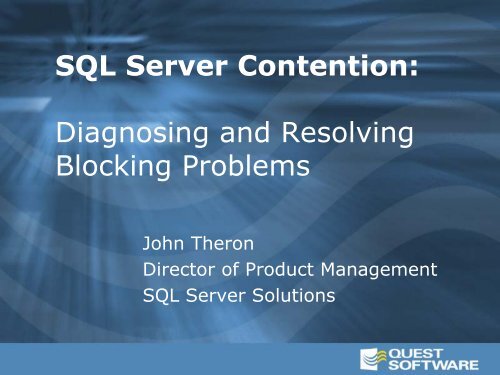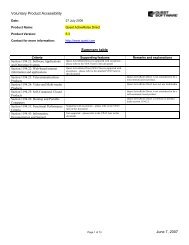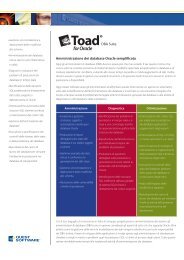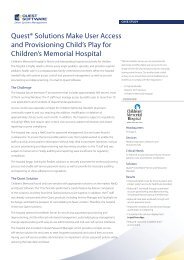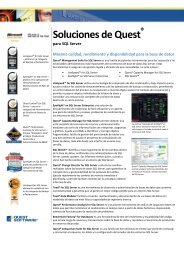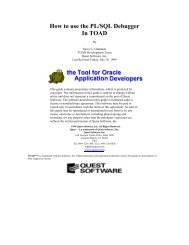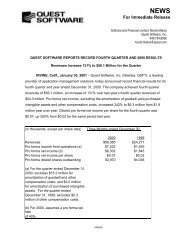SQL Server Contention: Diagnosing and Resolving ... - Quest Software
SQL Server Contention: Diagnosing and Resolving ... - Quest Software
SQL Server Contention: Diagnosing and Resolving ... - Quest Software
Create successful ePaper yourself
Turn your PDF publications into a flip-book with our unique Google optimized e-Paper software.
<strong>SQL</strong> <strong>Server</strong> <strong>Contention</strong>:<br />
<strong>Diagnosing</strong> <strong>and</strong> <strong>Resolving</strong><br />
Blocking Problems<br />
John Theron<br />
Director of Product Management<br />
<strong>SQL</strong> <strong>Server</strong> Solutions
Agenda<br />
� What is blocking?<br />
� Blocking in every day life<br />
� Locking basics<br />
� The impact of locking<br />
� Detecting, diagnosing <strong>and</strong> resolving<br />
blocking
Blocking<br />
� Occurs when one transaction locks<br />
the data resources that another<br />
wants to read or modify<br />
CustomerID<br />
10653<br />
10654<br />
CompanyName<br />
<strong>Quest</strong> <strong>Software</strong><br />
Ace Consulting<br />
ContactName<br />
Jim<br />
S<strong>and</strong>y
<strong>Contention</strong><br />
� Is inevitable as multiple users<br />
compete for resources<br />
� Is common in our daily lives
Lock Granularity<br />
� Row, page, table, index <strong>and</strong> index<br />
range<br />
� Also extent, application <strong>and</strong> database<br />
� Escalation occurs when row <strong>and</strong> page<br />
locks are promoted to table locks
Lock Compatibility<br />
N<br />
N<br />
N<br />
N<br />
N<br />
N<br />
N<br />
N<br />
N<br />
Sch-S<br />
N<br />
Y<br />
N<br />
Y<br />
Y<br />
Y<br />
Y<br />
Y<br />
Y<br />
Sch-M<br />
N<br />
N<br />
Y<br />
N<br />
N<br />
N<br />
N<br />
N<br />
N<br />
BU<br />
N<br />
Y<br />
N<br />
N<br />
N<br />
N<br />
N<br />
N<br />
N<br />
X<br />
N<br />
Y<br />
N<br />
N<br />
N<br />
N<br />
N<br />
N<br />
Y<br />
SIX<br />
N<br />
Y<br />
N<br />
N<br />
N<br />
Y<br />
N<br />
N<br />
Y<br />
IX<br />
N<br />
Y<br />
N<br />
N<br />
N<br />
N<br />
N<br />
Y<br />
Y<br />
U<br />
N<br />
Y<br />
N<br />
N<br />
N<br />
N<br />
Y<br />
Y<br />
Y<br />
S<br />
N<br />
Y<br />
N<br />
N<br />
Y<br />
Y<br />
Y<br />
Y<br />
Y<br />
IS<br />
Sch-S<br />
Sch-M<br />
BU<br />
X<br />
SIX<br />
IX<br />
U<br />
S<br />
IS<br />
Lock<br />
Mode
Transaction Isolation<br />
� Read Uncommitted<br />
� Read Committed<br />
� Read Repeatable<br />
� Read Serializable
Measuring the Impact<br />
Seconds<br />
120<br />
100<br />
80<br />
60<br />
40<br />
20<br />
0<br />
Transaction Times<br />
Baseline Wait Serializable Table Lock<br />
Ave<br />
Max
<strong>Diagnosing</strong>: Where to Start?<br />
trace flag 1200<br />
syslockinfo<br />
enterprise manager<br />
sp_lock<br />
sp_who<br />
DBCC<br />
performance monitor<br />
sysprocesses
The Diagnostic Process<br />
� Detect Blocking<br />
� Underst<strong>and</strong> the Chain<br />
� Determine the Extent of the Problem<br />
� Determine What locks the Lead<br />
Blocker is Holding<br />
� Underst<strong>and</strong> the Blocking Transaction
Demonstration
<strong>Resolving</strong> Blocking<br />
� Look beyond problem statements to<br />
the application <strong>and</strong> database design<br />
� Use your knowledge of your<br />
application <strong>and</strong> database to choose<br />
appropriate locking strategies
Conclusion<br />
� As applications scale <strong>and</strong> the number of<br />
users grows, contention for data resources<br />
becomes inevitable.<br />
� Good design will reduce the impact of<br />
blocking.<br />
� Tools <strong>and</strong> processes to speed the<br />
detection, diagnosis <strong>and</strong> resolution of<br />
blocking problems are important.
<strong>Quest</strong> Facts<br />
� <strong>Quest</strong> <strong>Software</strong> (NASDAQ:QSFT)<br />
– Founded 1987<br />
– Public in 1999<br />
� 1700 employees in 40 offices:<br />
– North America, South America,<br />
Europe, Asia, Australia<br />
� Application management leader:<br />
– 75% of Fortune 500<br />
– over 18,000 customers worldwide<br />
� 2003 revenues of $304 million<br />
– 19% growth from FY02<br />
� Helps develop, deploy, manage <strong>and</strong><br />
maintain enterprise applications without<br />
downtime or business interruption
What is <strong>Quest</strong> Central?<br />
� Single solution with multiple platform support<br />
– DB2, UDB, Oracle, MS <strong>SQL</strong> <strong>Server</strong><br />
– Z/os, OS/390, Unix, Linux, <strong>and</strong> Windows<br />
� Rich domain functionality<br />
– Database Administration<br />
Oracle<br />
– <strong>SQL</strong> Tuning<br />
DB2<br />
– Historical Performance Data<br />
– Space Management<br />
– Performance Diagnostics<br />
� Built-in Expertise<br />
– Built-in Knowledge Base<br />
– Product automates tuning methodology<br />
<strong>SQL</strong> <strong>Server</strong>


